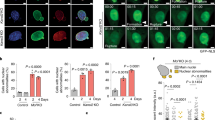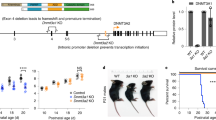Abstract
Gene transcription is critically influenced by chromatin structure and the modification status of histone tails1. Methylation of lysine residues in histone tails is dynamically regulated by the opposing activities of histone methyltransferases and histone demethylases2. Here we show that JARID1C/SMCX, a JmjC-domain-containing protein implicated in X-linked mental retardation and epilepsy3,4, possesses H3K4 tri-demethylase activity and functions as a transcriptional repressor. An SMCX complex isolated from HeLa cells contains additional chromatin modifiers (the histone deacetylases HDAC1 and HDAC2, and the histone H3K9 methyltransferase G9a) and the transcriptional repressor REST5, suggesting a direct role for SMCX in chromatin dynamics and REST-mediated repression. Chromatin immunoprecipitation reveals that SMCX and REST co-occupy the neuron-restrictive silencing elements in the promoters of a subset of REST target genes. RNA-interference-mediated depletion of SMCX derepresses several of these targets and simultaneously increases H3K4 trimethylation at the sodium channel type 2A (SCN2A) and synapsin I (SYN1) promoters. We propose that loss of SMCX activity impairs REST-mediated neuronal gene regulation, thereby contributing to SMCX-associated X-linked mental retardation.
This is a preview of subscription content, access via your institution
Access options
Subscribe to this journal
Receive 51 print issues and online access
$199.00 per year
only $3.90 per issue
Buy this article
- Purchase on Springer Link
- Instant access to full article PDF
Prices may be subject to local taxes which are calculated during checkout




Similar content being viewed by others
References
Jenuwein, T. & Allis, C. D. Translating the histone code. Science 293, 1074–1080 (2001)
Shi, Y. et al. Histone demethylation mediated by the nuclear amine oxidase homolog LSD1. Cell 119, 941–953 (2004)
Jensen, L. R. et al. Mutations in the JARID1C gene, which is involved in transcriptional regulation and chromatin remodeling, cause X-linked mental retardation. Am. J. Hum. Genet. 76, 227–236 (2005)
Tzschach, A. et al. Novel JARID1C/SMCX mutations in patients with X-linked mental retardation. Hum. Mutat. 27, 389–394 (2006)
Chong, J. A. et al. REST: a mammalian silencer protein that restricts sodium channel gene expression to neurons. Cell 80, 949–957 (1995)
Ogawa, H., Ishiguro, K., Gaubatz, S., Livingston, D. M. & Nakatani, Y. A complex with chromatin modifiers that occupies E2F- and Myc-responsive genes in G0 cells. Science 296, 1132–1136 (2002)
Kurokawa, R. et al. Polarity-specific activities of retinoic acid receptors determined by a co-repressor. Nature 377, 451–454 (1995)
Ballas, N. et al. Regulation of neuronal traits by a novel transcriptional complex. Neuron 31, 353–365 (2001)
Roopra, A., Qazi, R., Schoenike, B., Daley, T. J. & Morrison, J. F. Localized domains of G9a-mediated histone methylation are required for silencing of neuronal genes. Mol. Cell 14, 727–738 (2004)
Wang, H. et al. Role of histone H2A ubiquitination in Polycomb silencing. Nature 431, 873–878 (2004)
Tsukada, Y. et al. Histone demethylation by a family of JmjC domain-containing proteins. Nature 439, 811–816 (2006)
Whetstine, J. R. et al. Reversal of histone lysine trimethylation by the JMJD2 family of histone demethylases. Cell 125, 467–481 (2006)
Klose, R. J., Kallin, E. M. & Zhang, Y. JmjC-domain-containing proteins and histone demethylation. Nature Rev. Genet. 7, 715–727 (2006)
Clissold, P. M. & Ponting, C. P. JmjC: cupin metalloenzyme-like domains in jumonji, hairless and phospholipase A2beta. Trends Biochem. Sci. 26, 7–9 (2001)
Shi, Y. J. et al. Regulation of LSD1 histone demethylase activity by its associated factors. Mol. Cell 19, 857–864 (2005)
Mori, N., Schoenherr, C., Vandenbergh, D. J. & Anderson, D. J. A common silencer element in the SCG10 and type II Na+ channel genes binds a factor present in nonneuronal cells but not in neuronal cells. Neuron 9, 45–54 (1992)
Mortazavi, A., Thompson, E. C., Garcia, S. T., Myers, R. M. & Wold, B. Comparative genomics modeling of the NRSF/REST repressor network: from single conserved sites to genome-wide repertoire. Genome Res. 16, 1208–1221 (2006)
Vigo, E. et al. CDC25A phosphatase is a target of E2F and is required for efficient E2F-induced S phase. Mol. Cell. Biol. 19, 6379–6395 (1999)
Kearney, J. A. et al. A gain-of-function mutation in the sodium channel gene Scn2a results in seizures and behavioral abnormalities. Neuroscience 102, 307–317 (2001)
Lossin, C., Wang, D. W., Rhodes, T. H., Vanoye, C. G. & George, A. L. Molecular basis of an inherited epilepsy. Neuron 34, 877–884 (2002)
Lubec, G. & Sohn, S. Y. RNA microarray analysis of channels and transporters in normal and fetal Down syndrome (trisomy 21) brain. J. Neural Transm. Suppl. 67, 215–224 (2003)
Schousboe, A., Larsson, O. M., Sarup, A. & White, H. S. Role of the betaine/GABA transporter (BGT-1/GAT2) for the control of epilepsy. Eur. J. Pharmacol. 500, 281–287 (2004)
Abdolmaleky, H. M., Thiagalingam, S. & Wilcox, M. Genetics and epigenetics in major psychiatric disorders: dilemmas, achievements, applications, and future scope. Am. J. Pharmacogenomics 5, 149–160 (2005)
Lohoff, F. W. et al. Variations in the vesicular monoamine transporter 1 gene (VMAT1/SLC18A1) are associated with bipolar i disorder. Neuropsychopharmacology 31, 2739–2747 (2006)
Splawski, I. et al. CACNA1H mutations in autism spectrum disorders. J. Biol. Chem. 281, 22085–22091 (2006)
Johnson, R. et al. Identification of the REST regulon reveals extensive transposable element-mediated binding site duplication. Nucleic Acids Res. 34, 3862–3877 (2006)
Kuwahara, K., Takano, M. & Nakao, K. Pathophysiological significance of T-type Ca2+ channels: transcriptional regulation of T-type Ca2+ channel–regulation of CACNA1H by neuron-restrictive silencer factor. J. Pharmacol. Sci. 99, 211–213 (2005)
Nelson, K. B. et al. Neuropeptides and neurotrophins in neonatal blood of children with autism or mental retardation. Ann. Neurol. 49, 597–606 (2001)
Bahn, S. et al. Neuronal target genes of the neuron-restrictive silencer factor in neurospheres derived from fetuses with Down’s syndrome: a gene expression study. Lancet 359, 310–315 (2002)
Christensen, J. et al. RBP2 belongs to a family of demethylases, specific for tri-and dimethylated lysine 4 on histone 3. Cell 128, 1063–1076 (2007)
Iwase, S. et al. The X-linked mental retardation gene SMCX/JARID1C defines a family of histone H3 lysine 4 demethylases. Cell 128, 1077–1088 (2007)
Klose, R. J. et al. The retinoblastoma binding protein RBP2 is an H3K4 demethylase. Cell 128, 889–900 (2007)
Lee, M. G., Norman, J., Shilatifard, A. & Shiekhattar, R. Physical and functional association of a trimethyl H3K4 demethylase and Ring6a/MBLR, a polycomb-like protein. Cell 128, 877–887 (2007)
Lee, N. et al. The trithorax-group protein Lid is a histone H3 trimethyl-Lys4 demethylase. Nature Struct. Mol. Biol. (2007)
Secombe, J., Li, L., Carlos, L. & Eisenman, R. N. The Trithorax group protein Lid is a trimethyl histone H3K4 demethylase required for dMyc-induced cell growth. Genes Dev. 21, 537–551 (2007)
Seward, D. J. et al. Demethylation of trimethylated histone H3 Lys4 in vivo by JARID1 JmjC proteins. Nat. Struct. Mol. Biol. 14, 240–242 (2007)
Yamane, K. et al. PLU-1 is an H3K4 demethylase involved in transcriptional repression and breast cancer cell proliferation. Mol. Cell 25, 801–812 (2007)
Shi, Y. et al. Coordinated histone modifications mediated by a CtBP co-repressor complex. Nature 422, 735–738 (2003)
Acknowledgements
We thank Y. Shi and F. Lan for the gift of the His-JMJD2C protein. We also thank G. Mandel, T. Westbrook and P. Mulligan for sharing the anti-REST antibody and Y. Nakatani for the anti-RING2 antibody. This work was supported by NIH grants to Y.S. and by NIH and Harvard Stem Cell Institute (HSCI) grants to A.R. Y.S. is a PEW scholar. M.T. is supported by the HSCI and is a pre-doctoral fellow of the Ryan Foundation.
Author Contributions M.T. and P.M. contributed equally to this work.
Author information
Authors and Affiliations
Corresponding author
Ethics declarations
Competing interests
Reprints and permissions information is available at www.nature.com/reprints. The authors declare no competing financial interests.
Supplementary information
Supplementary Information
This file contains Supplementary Figures S1-S8 with Legends and Supplementary Table 1. Supplementary Figure S1 shows that GST-SMCX pulls down REST in vitro. Supplementary Figures S2-S5 contain additional data on the enzymatic activity of SMCX. Supplementary Figure S6 demonstrates that SMCX is a transcriptional co-repressor. Supplementary Figure S7 and S8 provide additional data on the effect of SMCX knockdown on histone methylation and acetylation both globally and at several REST target genes. Supplementary Table 1 summarises the effect of SMCX knockdown on the expression of genes in the RT-PCR array. (PDF 2562 kb)
Rights and permissions
About this article
Cite this article
Tahiliani, M., Mei, P., Fang, R. et al. The histone H3K4 demethylase SMCX links REST target genes to X-linked mental retardation. Nature 447, 601–605 (2007). https://doi.org/10.1038/nature05823
Received:
Accepted:
Published:
Issue Date:
DOI: https://doi.org/10.1038/nature05823
This article is cited by
-
Proximity labeling reveals a new in vivo network of interactors for the histone demethylase KDM5
Epigenetics & Chromatin (2023)
-
Genome-wide identification and expression analysis of the JMJ-C gene family in melon (Cucumis melo L.) reveals their potential role in fruit development
BMC Genomics (2023)
-
The histone demethylase KDM5C functions as a tumor suppressor in AML by repression of bivalently marked immature genes
Leukemia (2023)
-
A genome-wide screen reveals new regulators of the 2-cell-like cell state
Nature Structural & Molecular Biology (2023)
-
Expanding the genetics and phenotypic spectrum of Lysine-specific demethylase 5C (KDM5C): a report of 13 novel variants
European Journal of Human Genetics (2023)
Comments
By submitting a comment you agree to abide by our Terms and Community Guidelines. If you find something abusive or that does not comply with our terms or guidelines please flag it as inappropriate.



